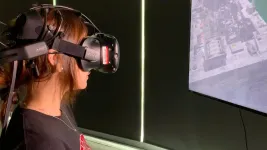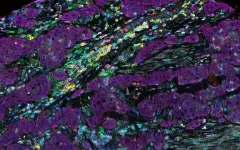(Press-News.org) As the COVID-19 pandemic wanes in the U.S., a new study from the University of Maryland School of Medicine (UMSOM) and University of Maryland Medical Center (UMMC) finds that hospitals nationwide may not be adequately prepared for the next pandemic. A 10-year analysis of hospitals' preparedness for pandemics and other mass casualty events found only marginal improvements in a measurement to assess preparedness during the years leading up to the COVID-19 pandemic. The study was published last month in the Journal of Healthcare Management.
"Our work links objective healthcare data to a hospital score that assesses the ability to save lives in a disaster," said study lead author David Marcozzi, MD, Professor of Emergency Medicine at UMSOM and Chief Clinical Officer/Senior Vice President at UMMC. "It attempts to fill a glaring gap in the national conversation on the need for improved assessments of and the opportunity for better hospital planning to assure readiness."
To conduct the research, Dr. Marcozzi, who is also the COVID-19 Incident Commander for the University of Maryland Medical System, and his colleagues first developed and published a surge index tool that linked standard reported hospital information to healthcare preparedness elements. The tool, called the Hospital Medical Surge Preparedness Index (HMSPI), used data from 2005 to 2014 to produce a score designed to predict how well a hospital can handle a sudden influx in patients due to a mass shooting or infectious disease outbreak. Such data included the size of the medical staff, the number of hospital beds, and the amount of equipment and supplies.
Medical surge capacity is an important measure to assess a hospital's ability to expand quickly beyond normal services to meet an increased demand for healthcare. The Las Vegas mass shooting in 2017, for example, sent more than 500 concertgoers to local hospitals. During the early weeks of the COVID-19 pandemic, New York City hospitals were under siege with 4,000 patients hospitalized. To calculate the HMSPI, researchers input data from four important metrics.
Staff: Doctors, nurses, pharmacists, respiratory technicians and others
Supplies: Personal protective equipment, cardiac monitors, sterile bandages, and ventilators
Space: Total beds and number of beds that current staff can handle
Systems: Framework for enabling electronic sharing of files and information between departments and multiple hospitals
In the new study, Dr. Marcozzi and his colleagues used data from the American Hospital Association's annual surveys of more than 6,200 hospitals nationwide that were collected from 2005 to 2014. They also employed data from the U.S. Census Bureau to determine population estimates in cities and the Dartmouth Atlas Project to establish the geographic service area of each hospital. They combined the hospital metrics gleaned from the AHA's annual surveys with the geographic data to calculate HMSPI composite scores for hospitals in each state.
Their evaluation found varying levels of increases in HMSPI scores from 2005 to 2014 in every state, which could indicate that states are becoming better prepared to handle a medical surge. The scores also indicated that ideal readiness had not yet been achieved in any state before the COVID-19 pandemic.
"This is just the starting point. We need to better understand the ability of our nation's hospitals to save lives in times of crisis," said Dr. Marcozzi. This information, and follow-up studies building from this work, will be key to better matching states' healthcare resources to their population to assure optimal care is delivered. Dr. Marcozzi described one follow-up study that would be impactful would be to use data from the COVID-19 pandemic to see whether the index was predictive to indicate which hospitals were most prepared for the pandemic surge based on their patient outcomes.
"This pioneering work is a needed advancement that could allow for a transparent assessment of a hospital's ability to save lives in a large-scale emergency," Dr. Marcozzi said. "The COVID-19 pandemic demonstrated that there is still plenty of room for improvement in the ability of our nation's healthcare system to triage and manage multiple patients in a crisis and that translates into lives lost, unnecessarily. Our research is dedicated to those who lost their lives in this tragedy and other mass casualty events. We can do better."
National health leadership organizations, such as the U.S. Centers for Medicare and Medicaid Services, the Assistant Secretary for Preparedness and Response, the Joint Commission, and the American Medical Association, as well as state and local emergency planners, could all potentially benefit from the use of HMSPI scores, according to Dr. Marcozzi. The tool could be used to support data-driven policy development and resource allocation to close gaps and assure that individuals get the care they need, when then need it, during a crisis.
Ricardo Pietrobon, MD, PhD, MBA, Adjunct Associate Professor of Emergency Medicine at UMSOM, Nicole Baehr, Manager of Operations at UMMC, and Brian J. Browne, MD, Professor and Chair of the Department of Emergency Medicine, were co-authors on this study. Researchers from the University of Nebraska Medical Center, University of Miami, and the U.S. Department of Veterans Affairs also participated in this research. The study was funded by the Bipartisan Commission on Biodefense.
"The COVID-19 pandemic taught us that we need to be better prepared for the unexpected crisis," said E. Albert Reece, MD, PhD, MBA, Executive Vice President for Medical Affairs, UM Baltimore, and the John Z. and Akiko K. Bowers Distinguished Professor and Dean, University of Maryland School of Medicine. "Having an important metric like the HMSPI could be a game changer that ultimately saves lives during a surge by helping hospitals identify and fix their vulnerabilities.
INFORMATION:
If a virtual world has ever left you feeling nauseous or disorientated, you're familiar with cybersickness, and you're hardly alone. The intensity of virtual reality (VR)--whether that's standing on the edge of a waterfall in Yosemite or engaging in tank combat with your friends--creates a stomach-churning challenge for 30-80% of users.
In a first-of-its kind study, researchers at the University of Maryland recorded VR users' brain activity using electroencephalography (EEG) to better understand and work toward solutions to prevent cybersickness. The research was conducted by Eric Krokos, who received his Ph.D. in computer science in 2018, and Amitabh Varshney, a professor of computer science ...
Although wastewater disposal has been the primary driving force behind increased earthquake activity in southern Kansas since 2013, a new study concludes that the disposal has not significantly changed the orientation of stress in the Earth's crust in the region.
Activities like wastewater disposal can alter pore pressure, shape and size within rock layers, in ways that cause nearby faults to fail during an earthquake. These effects are thought to be behind most recent induced earthquakes in the central and eastern United States.
It is possible, however, that human activity could also lead to earthquakes by altering the orientation of stresses that act on faults in the region, said U.S. Geological Survey seismologist ...
As more evidence emerges that opioid overdose deaths have increased dramatically since the onset of COVID-19, the Centre for Addiction and Mental Health (CAMH), in collaboration with subject matter experts and medical regulatory authorities across Canada, have now released updated national clinical guidelines for the treatment of opioid use disorder. END ...
When someone is suspected of criminal activity, one of the most important questions they are asked is if they have a credible alibi. Playing back past events in our minds, however, is not like playing back a video recording. Recollections of locations, dates, and companions can become muddled with the passage of time. If a suspect's memories are out of line with documented events, a once-plausible alibi can crumble and may be seen as evidence of guilt.
To put people's memories of past whereabouts to the test, a team of researchers tracked the locations of 51 volunteers for one month and found that their recollections were wrong approximately 36% of the time.
"This is the first study to examine memory for where ...
Uppsala University scientists have designed a new mouse model that facilitates study of factors contributing to the progression of human bladder cancer and of immune-system activation when the tumour is growing. Using this model, they have been able to study how proteins change before, while and after a tumour develops in the bladder wall. The study has now been published in the scientific journal PLOS ONE.
"The model was designed both to contain specific oncogenes, as they're called -- mutations that can drive tumour growth -- and to show a high incidence of harmful mutations, which we often see in people who get bladder cancer. These harmful mutations arise because of smoking, for instance, which is ...
Sudanese Islamic burial sites are distributed according to large-scale environmental factors and small-scale social factors, creating a galaxy-like distribution pattern, according to a study published July 7, 2021 in the open-access journal PLOS ONE by Stefano Costanzo of the University of Naples "L'Orientale" in Italy and colleagues.
The Kassala region of eastern Sudan is home to a vast array of funerary monuments, from the Islamic tombs of modern Beja people to ancient burial mounds thousands of years old. Archaeologists don't expect these monuments are randomly placed; their ...
GPS data from cell phones may provide insight into how city inhabitants are using their urban greenspaces, in a study published July 7, 2021 in the open-access journal PLOS ONE by Meghann Mears and Paul Brindley from the University of Sheffield, UK, and colleagues.
Urban greenspaces confer a range of health and well-being benefits on city inhabitants and provide connection to nature. In this study, Mears and colleagues use cellphone GPS data to assess how frequently residents of the city of Sheffield in the UK engage with their local urban greenspaces, and whether this engagement was different across demographic groups.
The authors used the "Shmapped" app, developed as part of the Improving Well-being through Urban Nature project, to track how frequently 240 users based in Sheffield ...
New iguanodon-like dinosaur identified from jawbone fossil from Spain was likely a 6-8m long herbivore, closely related to species found in modern-day China and Niger.
INFORMATION:
Article Title: A new Styracosternan hadrosauroid (Dinosauria: Ornithischia) from the Early Cretaceous of Portell, Spain
Funding: The authors received no specific funding for this work.
Competing Interests: The authors have declared that no competing interests exist.
Article URL: https://journals.plos.org/plosone/article?id=10.1371/journal.pone.0253599
...
Brain microstructure may help explain the benefits of physical activity on cognition in older adults, according to MRI scans of 318 brains post-mortem.
INFORMATION:
Article Title: Physical activity, brain tissue microstructure, and cognition in older adults
Funding: This work was supported in part by the National Institute on Aging (https://www.nia.nih.gov) grants K25 AG61254 (RJD), K01 AG64044 (VNP), K01 AG50823 (BDJ), R01 AG17917 (DAB), R01 AG47976 (ASB), R01 AG56352 (ASB), R01 AG64233 (JAS, KA), and P30 AG10161 (DAB), the National Institute of Neurological Disorders and Stroke (https://www.ninds.nih.gov) grant UH3 NS100599 ...
HOUSTON - (July 7, 2021) - A thin shell of soft polymer can help keep knotty ceramic structures from shattering, according to materials scientists at Rice University.
Ceramics made with 3D printers crack under stress like any plate or bowl. But covered in a soft polymer cured under ultraviolet light, the same materials stand a far better chance of keeping their structural integrity, much like a car windshield's treated glass is less likely to shatter.
The research at Rice's Brown School of Engineering, which appears in Science Advances, demonstrates the concept on schwarzites, complex lattices that for decades existed only as theory but can now be made with 3D printers. With added polymers, they come to resemble structures ...





